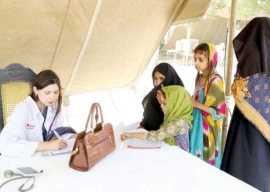
Another death anniversary of Sir Ganga Ram best known for a hospital named after him in the city passed unobserved on July 10. No public event was held in the city to mark the day.
Rights activist Munawar Ali Shahid said he believed that the government had not held any ceremony on the death anniversary to remember his services for the city because of his faith. In a telephonic conversation with The Express Tribune, he said an unfortunate trend had evolved in the South Asian region that people’s religious beliefs determined if they would be remembered and honoured in public discourse.
Shahid referred as evidence to the Punjab Assembly’s recent refusal to carry a resolution seeking renaming of a road in the city after Dr Gottlieb Wilhelm Leitner, a 19th century British linguist who served as principal of the Government College, Lahore. He said he believed the resolution was rejected because Dr Leitner was Jewish. He said Dr Leitner had rendered great services for promotion of education in the city. “It is lamentable that the assembly turned down the resolution,” he said.
In a press statement issued on July 10, National Assembly Member Dr Ramesh Kumar Vankawani, the patron-in-chief of the Pakistan Hindu Council, had asked the provincial government to include lessons on Sir Ganga Ram in the curriculum for public schools. He had also expressed disappointment on the dismal condition of Ganga Ram’s samadhi on Ravi Road.
The Samadhi is spread over an area of 13,000 square feet. Talking to The Tribune, Hakeem Rasheed Ahmed Baig, a resident of a neighbouring locality, said he could not recall any effort undertaken by the provincial government to renovate it. He said minor repairs were undertaken at the site during General Musharaf’s days. There had been no repair or maintenance work since then, he added.
Baig recalled that a charged mob had attacked and vandalised the samadhi in December 1992 following the demolition of Babri Mosque in India. He said the mob had damaged the tomb and several windows and doors made of sandalwood and demolished four minarets and six pillars. He said the mob had also vandalised fountains in a pool located in the central courtyard.
Baig said adjacent buildings of two shrines and a mosque were originally attached to the samadhi and were used as residential quarters and dining area for pilgrims who visited it every year on Baisakhi. “The people who had encroached upon these buildings were influential,” he said.
Sayed Bahadar Ali, a self-appointed caretaker at the samadhi, said he had been living there since 1947. He said he was among the people housed by the federal government in the quarters attached with the samadhi on their arrival in the city. He said most others left the area in 1982 after they were each allotted 5-marla residential plots. He said he was not given one so he continued to live at the premises.
Ali said he could not recall a day when he had not swept the samadhi and the attached courtyard. It appeared that his efforts alone were not enough to ensure cleanliness at the site as heaps of garbage had piled up in the courtyard.
Ganga Ram had died on July 10, 1927. During his career as an executive engineer in the British government in the Punjab, he designed building plans for several buildings in the city. These included the General Post Office, the Lahore Museum, the Aitchison College, the Mayo School of Arts (now known as the National College of Arts), the Sir Ganga Ram Hospital, Lady Mc Lagan Girls High School, Chemistry Department building at the Government College, the Albert Victor wing of Mayo Hospital, Sir Ganga Ram High School (now Lahore College for Women University), the Hailey College of Commerce, the Ravi Road House for the Disabled, the Ganga Ram Trust Building on The Mall, and the Lady Maynard Industrial School. He also designed the plan for Model Town Housing Society.
Published in The Express Tribune, July 16th, 2015.







1726722687-0/Express-Tribune-Web-(9)1726722687-0-270x192.webp)









COMMENTS (1)
Comments are moderated and generally will be posted if they are on-topic and not abusive.
For more information, please see our Comments FAQ